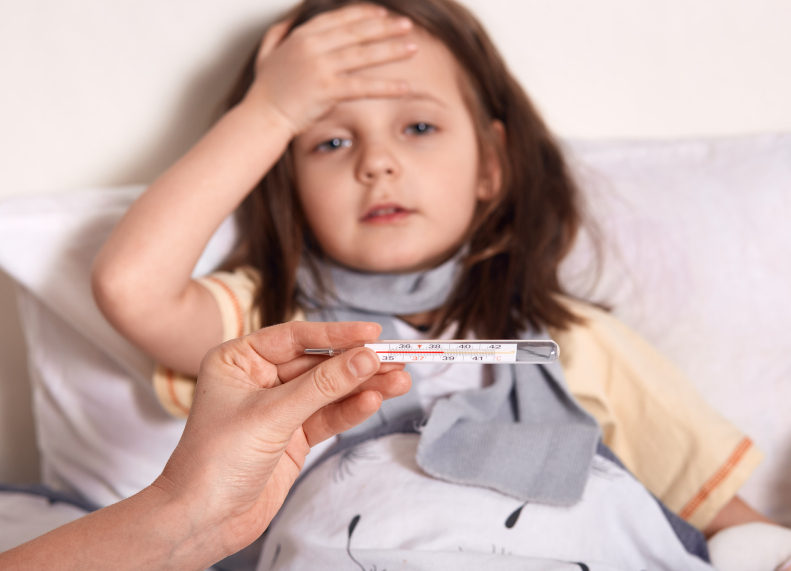
+90 216 759 20 21
Bağdat Cad. Feneryolu Özgen Apt. No:121 D:6 Kadıköy/İstanbul

1. Acute Respiratory Tract Infections
These are the most common and often fatal infectious diseases in childhood. Acute respiratory tract infections (ARTIs) can be divided into upper and lower respiratory tract infections. Most of these are upper respiratory tract infections (URTIs). Viruses are the most common causes of URTIs, and they typically resolve spontaneously. Diseases involving the larynx and the region below it are considered acute lower respiratory tract infections, including croup, acute bronchiolitis, acute bronchitis, and pneumonia.
2. Fever – Common Cold – Rhinitis
Normal body temperature ranges from 36 to 37.5 degrees Celsius and can vary throughout the day. A temperature of 38 degrees or higher may be a sign of illness. However, if a child has been active during the day, a short-term increase in body temperature can be observed. Colds in children should be taken more seriously than in adults, and medical attention should be sought. To lower a child's high fever, avoid excessive covering, provide plenty of fluids, and use lukewarm showers.
Symptoms of the Flu in Children
3. Otitis Media
Middle ear infections (otitis media) are a very common disease, particularly in children, and almost every child experiences it at least once or sometimes repeatedly. Restlessness, ear pulling, and frequent infections are often observed in infants. During a cold, nasal congestion can lead to sneezing and irritation, which can introduce germs into the ear.
4. Sinusitis
Sinusitis is one of the most common diseases in children. The most common microorganisms in sinusitis are Haemophilus influenzae and Streptococcus pneumoniae. Symptoms include severe pain in the facial bones and increased pain when leaning forward. Other symptoms include tearing of the eyes, swelling around the eyes, a fever below 38 degrees Celsius, and increased pain upon pressing the face. The examination typically reveals swollen and highly reddened nasal mucosa.
Treatment involves antibiotics and nasal decongestants. The treatment should last for more than 10 days. Untreated sinusitis can lead to complications, as the infection can spread to the eye and the membranes of the brain. However, these complications are not very common.
5. Bronchitis
Laryngitis is an inflammatory disease that can occur at any age. Both viruses and bacteria can cause inflammation in the larynx and vocal cords. This condition can result in hoarseness, and fever does not typically rise significantly. Sometimes, it can worsen and cause severe respiratory distress in children. The culprits are often the same viruses and bacteria mentioned earlier.
Treatment involves antibiotics and, depending on the severity of breathing difficulties, the use of corticosteroids. In some cases, when the airway is completely obstructed, a hole may be made in the trachea. This procedure, called a tracheotomy, can be a life-saving intervention.
6. Urinary Tract Infections
Urinary tract infection (UTI) refers to the proliferation of microorganisms in the urinary system. It is one of the most common bacterial infections in children. Bacteria, viruses, and fungi can cause UTIs. It can affect people of all ages and genders, but it is more commonly observed in females, with the exception of newborns. UTIs can lead to permanent and progressive damage, especially in the first five years. Failure to detect this condition and failure to control infections can lead to kidney failure.
Urinary Tract Infections According to Age Groups
The goal of treatment is to eliminate the infection, identify and correct anatomical and functional disorders, prevent recurrences, and preserve kidney function.
7. Diarrhea
Diarrhea is simply defined as having loose stools. It usually begins suddenly and is characterized by an increased number of bowel movements (more than three times a day). Diarrhea is most common in children aged 0-5 years.
Vomiting and diarrhea are symptoms of Acute Gastroenteritis, which is the same disease. Most children with diarrhea also experience vomiting, and sometimes vomiting is the only symptom of Acute Gastroenteritis.
There are three important principles in the treatment of diarrhea: First, replace lost fluids and electrolytes as much as possible, second, continue feeding, and third, seek medical attention in a timely manner. Most cases of diarrhea in children are mild to moderate and can be treated at home. In mild diarrhea cases, the child appears well, does not have persistent vomiting or fever, and can be managed by providing frequent oral fluids, continuing breastfeeding or formula feeding, and monitoring for signs of dehydration. In moderate cases of diarrhea, children may be restless and very thirsty. These children, if older than six months, can be treated at home using oral rehydration solutions. Children showing signs of dehydration should be taken to a doctor.